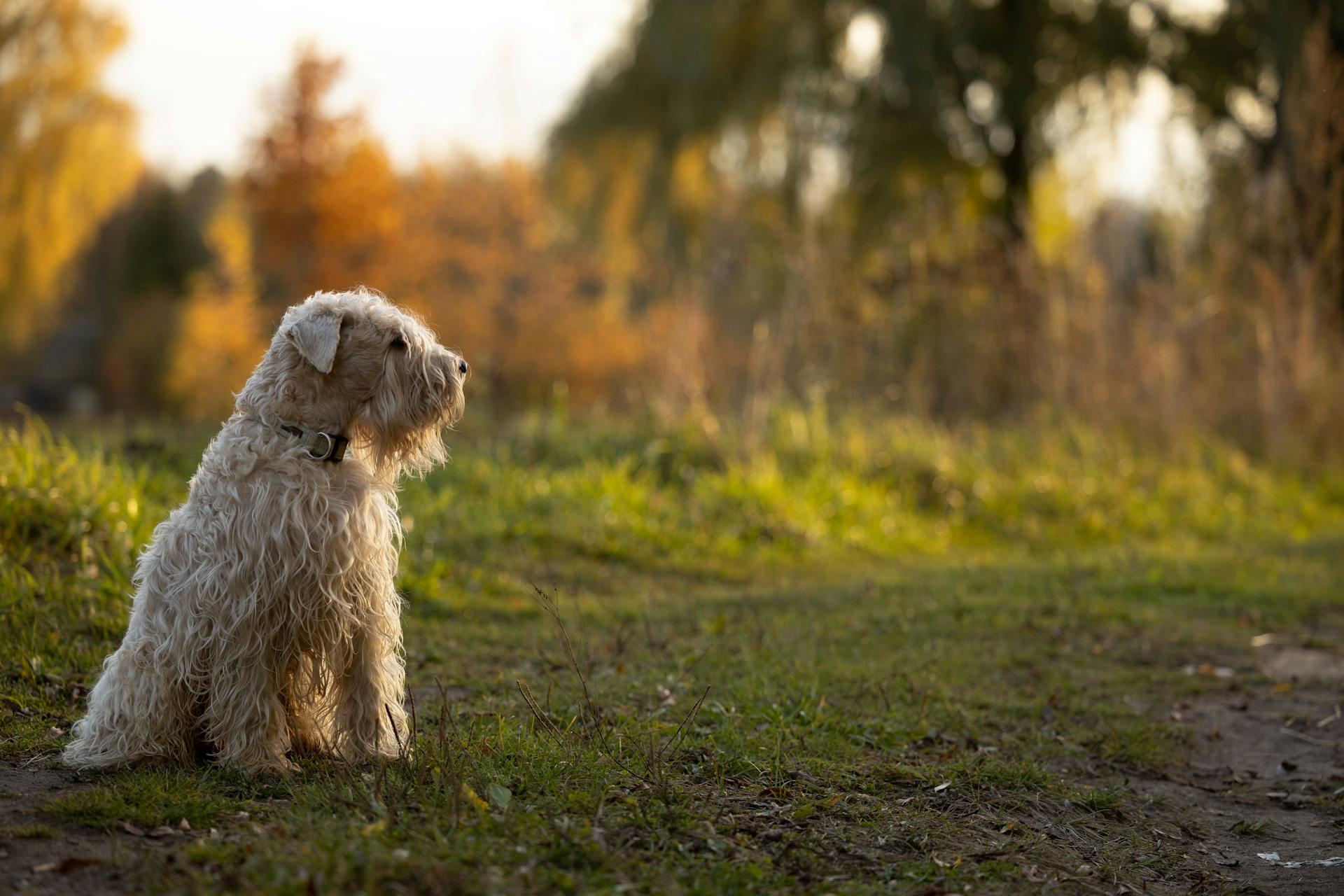
The Patterdale Terrier Mix is a delightful and energetic companion, but it's essential to understand their characteristics, care, and training needs.
Patterdale Terrier Mixes are naturally curious and love to explore their surroundings, often getting into mischief if left unattended.
They require regular exercise to keep them happy and healthy, with at least 30 minutes of physical activity daily.
A Patterdale Terrier Mix will thrive in a family with an active lifestyle, as they love to join in on outdoor adventures.
Their intelligence and energy level make them highly trainable, but consistency and positive reinforcement are key.
With patience and practice, you can teach your Patterdale Terrier Mix to obey basic commands and behave well in public.
Physical Characteristics
Patterdale Terriers are small, sturdy dogs with square bodies, strong necks, and powerful jaws. They have enough flexibility to squeeze through tight passageways when tracking quarry.
Their coats come in three types: smooth, broken, and rough. Broken coats have coarse, wiry guard hairs that are longer than the smooth coat type's, and may also have facial furnishings.
Patterdales weigh between eleven and 13 pounds and stand between twelve and 15 inches at the shoulders.
Curious to learn more? Check out: Smooth Fox Terrier Mix
General Appearance
Patterdale Terriers are small, sturdy dogs with square bodies.
Their strong necks and powerful jaws make them well-suited for tracking quarry.
They have enough flexibility to squeeze through tight passageways, which is essential for their hunting style.
The average weight for a Patterdale Terrier is between eleven and 13 pounds.
They typically stand between twelve and 15 inches at the shoulders.
Keep in mind that individual dogs may vary in size, with some being smaller or larger than average.
Coat and Coloring
The Patterdale Terrier's coat is quite unique and comes in three different types: smooth, broken, and rough. The smooth coat is coarse and dense, while the broken coat has longer guard hairs and facial furnishings. A rough coat, on the other hand, is coarse and longer than the other two types, and always has facial furnishings.
One of the most distinctive features of the Patterdale Terrier's coat is its coloring. They come in a variety of standard colors, including black, red, chocolate, grizzle, black and tan, and bronze. White markings on the chest and feet are also common.
On a similar theme: Patterdale Terrier Brown and Black

Here's a breakdown of the different coat types and their characteristics:
Their coat is very easy to care for, requiring only a good brush per week to keep them in tip-top shape. Shampooing should be done only as needed, as they have oils that help them tolerate warm and cold weather.
Temperament and Personality
Patterdale Terrier mixes are known for their feisty, loyal nature, making them excellent companions for experienced pet parents.
They're social dogs that thrive on human interaction and can become destructive if left alone for long periods. This means they need regular attention and exercise to prevent separation anxiety.
These energetic dogs love to have a job to do and can keep their owners on their toes with their lively, fun-spirited personalities. They're perfect for active people who can give them plenty of attention and keep them busy.
Patterdale Terrier mixes are generally great with kids and make excellent family pets, but they do require early socialization to ensure they grow into well-adjusted adult dogs.
Patterbea
The Patterbea is a breed that requires a firm hand due to its tenacious nature. They need at least an hour of exercise daily to keep them happy and healthy.
One of the challenges of owning a Patterbea is their stubbornness, which can make training a bit tricky. They're also quite vocal, thanks to their Beagle side.
A Patterbea's coat can be either smooth or coarse, but it's more common for them to have a solid coat. Occasionally, you might see Beagle markings in a litter.
Unfortunately, Patterbeas are prone to some health issues, including eye problems like cataracts and glaucoma.
Temperament and Personality
Patterdales are feisty, loyal dogs that make excellent companions for experienced pet parents looking for a high-energy sidekick.
They're prone to separation anxiety and may be destructive if left alone for long periods, so it's essential to provide them with plenty of attention and socialization.
Patterdales are social dogs that like to be around their people, and they thrive on interaction, which is why they're not a good fit for homes where people are away for extended periods.
They need socialization when they're puppies to prevent them from being fearful of or reactive toward strangers, and this process helps them grow into well-adjusted adult dogs.
Patterdales have a strong prey drive, which means they may not be a good fit for homes with other small pets, and they require a secure, fenced yard to keep them safe and the neighborhood critters safe from them.
They're a big dog in a small package, and they're outgoing, lively, and fun-spirited, making them a great match for an active person who can give them plenty of attention.
Patterdales love to have a job to do, no matter how big or small, and they can be very willful, so positive reinforcement is the recommended route to take when it comes to training.
They'll rack up lots of steps keeping up with them, and they need early socialization to ensure they grow up to be a well-rounded dog.
Patterdales love kids and make excellent family pets because they're able to keep up with kids of all ages, and they'll enjoy a game of fetch just as much as an interactive, stimulating toy or a long walk.
They should not be left alone for long periods of time as they are prone to destructive behavior when they feel isolated.
Health and Care
Patterdale Terrier mixes are generally sturdy and healthy, but like all breeds, they can be prone to certain health issues. Regular veterinary checkups are essential to detect any concerns early.
Some common health problems Patterdale Terriers may suffer from include dry skin, lens luxation, intervertebral disc disease, hypothyroidism, and hip dysplasia. These conditions can cause discomfort, vision problems, and even pain.
To keep your Patterdale Terrier mix healthy, make sure to provide a balanced diet rich in nutrients, vitamins, and minerals. You can start with 3-4 smaller servings a day for growing pups and adjust to two meals a day as they get older. Regular exercise, such as a daily half-hour to hour-long walk, is also crucial to maintain their weight and overall health.
Here are some common health issues to monitor:
- Dry skin
- Lens luxation
- Intervertebral disc disease
- Hypothyroidism
- Hip dysplasia
It's also essential to check and clean their ears regularly to prevent ear infections, trim their nails to prevent overgrowth, and brush their teeth to prevent dental issues. Regular health checks with your vet will help identify any potential problems early on.
Health

Patterdale Terriers are generally sturdy and healthy, but some may be prone to certain health issues. Regular veterinary checkups can help detect these problems early.
Dry skin is a common condition in Patterdale Terriers, caused by factors such as genetics, environment, and diet. It can cause discomfort and irritation for your furry companion.
Lens luxation is a serious eye condition where the lens dislocates from its normal position, affecting a dog's vision and overall eye health. This condition can be caused by degeneration of the fibers that hold the lens in place.
Intervertebral Disc Disease (IVDD) is a common spinal condition that affects the cushion-like structures between the vertebrae. It can cause neurological symptoms and range from mild to severe.
Patterdale Terriers are prone to weight gain due to their high energy levels. Regular exercise, such as a daily 30-minute walk, can help keep them healthy.
Ear infections are common in Patterdale Terriers due to their floppy ears. Regular ear cleaning can help prevent this issue.
For another approach, see: Patterdale Terrier Health Problems

Dental issues, such as gum disease, are common in small breeds like Patterdale Terriers. Brushing their teeth regularly can help prevent these problems.
Here are some possible health complications to be aware of:
- Dental issues and gum disease
- Infections
- Canine obesity and weight gain
- Dog allergies (including fleas, food, and pollen)
- Eye problems
- Intervertebral Disc Disease (a condition that affects the dog's back)
Health and Care
Patterdale Terriers are generally a healthy breed, but they do have some specific needs when it comes to their health and care.
Regular grooming is essential to prevent tangles and loose hair, and a weekly brush with a slicker brush will do the trick.
To keep their coat in tip-top shape, a good brush per week is all you need, regardless of the coat type.
Their coat comes in a variety of colors, including pied, black, red, and brown, and can be smooth, broken, or rough.
A Patterdale Terrier's coat is easy to care for, but they do require regular nail trims, ear cleanings, and the occasional bath.
Dental disease is a common health condition in adult dogs, so it's essential to establish a good dental hygiene program, including professional cleanings and at-home teeth brushing.

Patterdale Terriers have oils that help them tolerate warm and cold weather, but they can still get dry skin if they don't get enough moisture.
Their shedding habits vary depending on the coat type, but they are generally considered light shedders.
Here's a quick rundown of the different coat types and their characteristics:
Overall, with regular grooming and care, your Patterdale Terrier can live a happy and healthy life.
Nutrition
Patterdale Terriers thrive on a high-quality diet formulated for their life stage and energy level.
To help your dog maintain a healthy weight, keep an eye on their food intake and measure their portions to avoid overfeeding.
Treats should make up no more than 10% of a dog's daily calories, so be mindful of those tasty snacks.
A balanced diet is essential for your Patterdale's overall health, rich in nutrients, vitamins, and minerals.
Growing pups may prefer 3-4 smaller servings during the day, rather than two larger meals.

As your dog gets older, you can reduce the number of meals to two a day.
The recommended portion size will depend on your individual dog's activity level, age, and metabolism.
Make sure your dog's healthy diet is balanced with plenty of exercise to avoid weight gain.
For dietary advice specific to your individual dog, have a chat with your local vet or the breeder you're purchasing your puppy from.
Frequently Asked Questions
What are Patterdale Terriers a mix of?
Patterdale Terriers are believed to be a mix of the Northumberland Pit terrier and the Old English terrier, or possibly the Fell terrier and the Border Terrier, with both origins being strong possibilities.
Is a Patterdale Terrier a good family dog?
Patterdale Terriers are a great fit for active families with respectful children and other pets, but socialization from an early age is key to ensuring a harmonious household. With proper care and attention, they can thrive as loving and energetic family companions.
How big can a Patterdale Terrier get?
According to the UKC standard, a Patterdale Terrier typically stands between 25-38 centimeters tall. They should be compact and balanced in appearance, with a fit and active physique.
Do Patterdale Terriers bark a lot?
Patterdale Terriers are prone to barking, especially if left alone, and require early training to manage this behavior.
Featured Images: pexels.com


